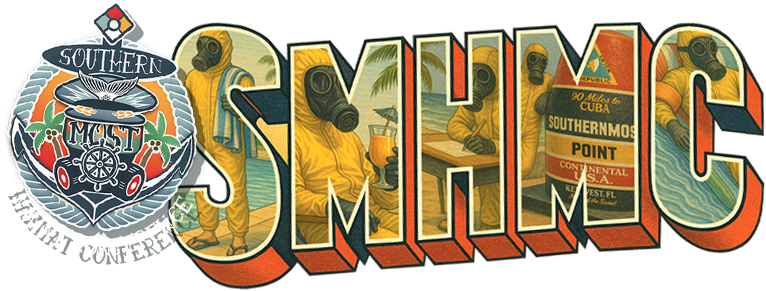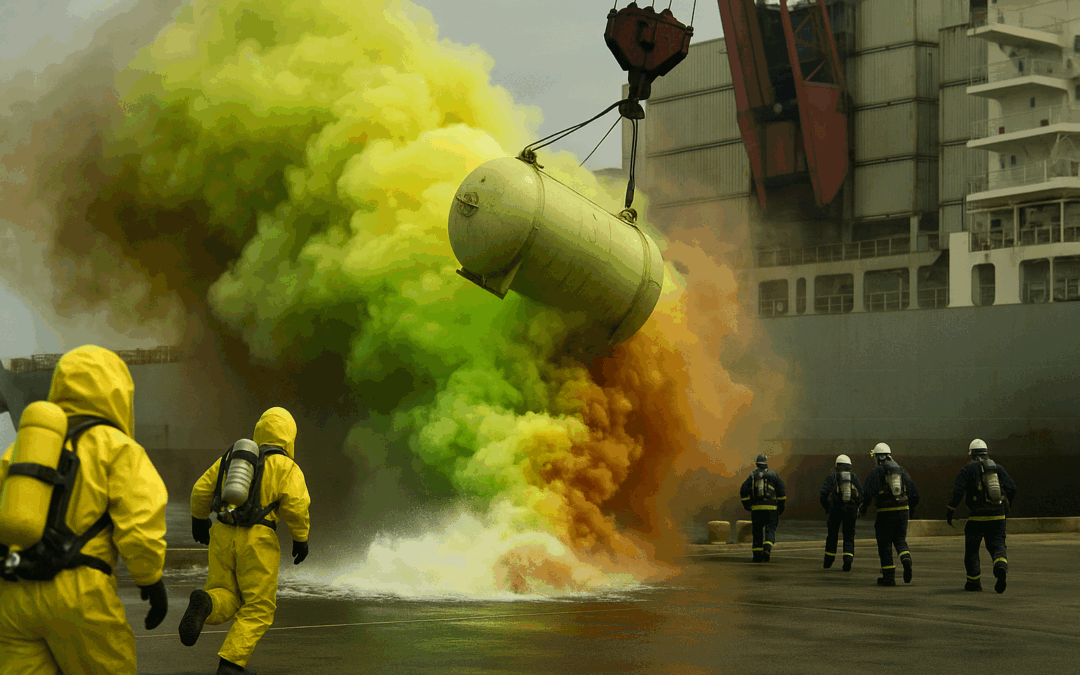When Chlorine Hits Hard: Lessons from the Jordan Gas Release
When I sat down with Bobby Salvesen and Mike Monaco for Episode 346 of The Haz Mat Guys Podcast, we knew we had a big one to unpack. A chlorine cylinder had dropped from a container ship in Jordan, unleashing a plume of toxic gas that killed 10 people and injured at least 400 more. Social media lit up with footage of the event, and within minutes, it became a major talking point across the hazmat community.
Mike first caught the news while teaching a class on chlorine kits. As he told me, “I looked down at my phone and saw it. Ten dead. Two-fifty hurt. Chlorine release. Holy crap.”
So we got to work dissecting what actually happened.
Chlorine 101: The Behavior Behind the Disaster
The video shows the cylinder dropping from a crane, cracking open on impact, and unleashing a burst of vibrant greenish-yellow vapor that sinks immediately. Chlorine is heavier than air. It doesn’t rise and dissipate quickly like some other gases – it flows downwards, into lower spaces, hugging the ground or in this case, the deck and water below.
But what really caught our eye was the color change. It starts green, then turns brownish-red. Bobby wondered aloud: “Did the chlorine oxidize something? Is it just the crappy color on the security camera?” Good questions. The answer isn’t clear, but it points to something we see all the time: conditions at a hazmat scene can change fast, and you won’t always have the perfect intel.
No Mitigation? Think Again
From a pure mitigation standpoint, Mike was honest: “There’s nothing to do on this run.” Once liquid chlorine hits the air and boils off, it’s game over for containment. But that doesn’t mean there’s no role for hazmat.
In fact, the work is just beginning.
You’re not going to patch a leaking container that just bled out its entire load. Instead, you focus on:
- Rescue operations: Above deck might be survivable. Below deck? Not likely. The consensus: chlorine would snake down into the bowels of the ship, turning it into a toxic swimming pool.
- Evaluating other containers: The oxidizing nature of chlorine means any neighboring materials – gaskets, pipes, valves, greases, or fuels – could now be compromised. That’s a huge secondary hazard.
- Air monitoring: Chlorine pockets could linger in corners or enclosed spaces. If you don’t find them, someone else might stumble into them later.
PPE: Why Level A Isn’t Always the Answer
This part of the discussion stirred up a lot. Traditionally, chlorine means Level A. But the reality is more nuanced.
Bobby and Mike argued strongly for Type 1 NFPA 1994 suits – suits rated for high concentrations of chemical vapors but that offer more flexibility than bulky Level A ensembles. Picture trying to climb nearly vertical ladders and navigate tight corridors in a rigid, oversized moon suit. It’s not ideal.
“You work with what you have,” said Mike. “If you’ve only got Level A, fine. But if you’ve got better options like a 1994 suit, you can search faster and safer.”
If your department doesn’t have these suits, consider who nearby might. Bobby mentioned Sacramento’s FEMA Task Force as a potential resource for borrowing gear. Know your neighbors.
Triage and Tactical Priorities
This wasn’t just about chlorine. As Mike put it: “We need to evaluate everything the chlorine touched.” That includes containers, fuel systems, valves, and even the structure of the ship. Everything becomes suspect after an oxidizer release.
And here’s a critical point: your role may change during the operation.
- Early responders may focus on life-saving search and rescue in SCBA and bunker gear.
- Hazmat techs arriving later may shift toward air monitoring and container evaluation.
- Teams might need to switch PPE ensembles as operations progress.
“We used to think of PPE in terms of A, B, C,” Bobby said. “Now we have a dozen options. We need to match the gear to the task.”
The Big Picture: Planning, Resources, and Real-World Hurdles
The Jordan incident also raised questions about marine evacuations. If a chlorine plume spreads over water, how do you warn boaters? Who do you send into an IDLH atmosphere to do that work? These are real operational and logistical puzzles, especially in areas with little regulatory oversight.
You also have to plan for the long haul. This isn’t a one-and-done call. Crews will be evaluating containers for days, maybe longer. The ship becomes a hazmat zone, and everything in it needs to be treated with caution.
Real-World Takeaways for Hazmat Teams
- Train for complexity. Incidents rarely go textbook. Expect chaos, ambiguity, and hard calls.
- Know your gear. If you’re not familiar with NFPA 1994 suits or MT-94s, it’s time to learn. They may give you safer, smarter options.
- Map your mutual aid. Who near you has what gear? Can you borrow it? Do you have agreements in place?
- Don’t stop at the initial hazard. Secondary reactions and exposures are often more dangerous than the original release.
- Match PPE to the mission. Not every situation calls for Level A. Don’t let old-school habits override smart decisions.
Final Thoughts
This episode reminded us that chemical releases like chlorine are as much about tactics and thinking as they are about gear. Yes, the footage was terrifying. Yes, the loss of life was tragic. But within that chaos is a call to learn, adapt, and prepare for the next one.
As Mike said, “We still have a lot to do.” The chlorine may be gone, but the work of hazmat response is just getting started.



Great information and insight into the situation and what are consideration during this type of event. Thanks for sharing,